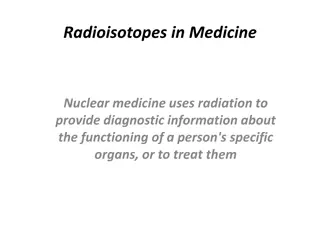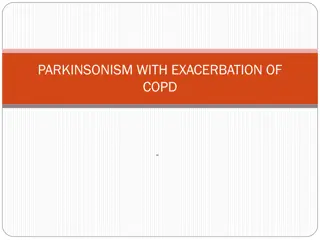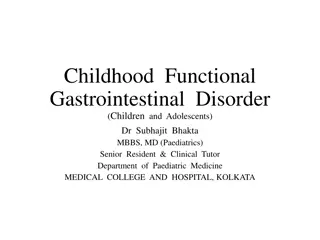Movement Disorders Society Diagnostic Criteria for Parkinsonism
The Movement Disorders Society Diagnostic Criteria outline the presence, exclusion, and supportive criteria for diagnosing parkinsonism. These criteria help differentiate between clinical PD, prodromal PD, and other conditions presenting with similar symptoms like bradykinesia, resting tremor, and rigidity.
Uploaded on Mar 08, 2025 | 1 Views
Download Presentation

Please find below an Image/Link to download the presentation.
The content on the website is provided AS IS for your information and personal use only. It may not be sold, licensed, or shared on other websites without obtaining consent from the author.If you encounter any issues during the download, it is possible that the publisher has removed the file from their server.
You are allowed to download the files provided on this website for personal or commercial use, subject to the condition that they are used lawfully. All files are the property of their respective owners.
The content on the website is provided AS IS for your information and personal use only. It may not be sold, licensed, or shared on other websites without obtaining consent from the author.
E N D
Presentation Transcript
Summary of the Movement Disorders Society Diagnostic Criteria Establish Parkinsonism PRESENT PRESENT Absolute Exclusion Criteria Bradykinesia AND Not Clinical PD Resting tremor OR Rigidity ABSENT ABSENT Not Clinical PD Not Clinical PD OR Consider Prodromal PD >2 RED FLAGS Clinically Probable PD 2 RED FLAGS Balanced by equal number of SUPPORTIVE CRITERIA Clinically Established PD No RED FLAGS 2 SUPPORTIVE CRITERIA PostumaRB, Berg D, Stern M, et al. MDS clinical diagnostic criteria for Parkinson s disease. Mov Disord. 2015;30:1591-1599.
MDS Absolute Exclusion Criteria Absolute Exclusion Criteria Unequivocal cerebellar abnormalities Downward vertical supranuclear palsy or selective slowing of downward vertical saccades Probable behavioral variant frontotemporal dementia or primary progressive aphasia within 5 years Parkinsonian features restricted to lower limbs for >3 years Possible drug-induced parkinsonism No response to high-dose levodopa despite at least moderate disease Unequivocal cortical sensory loss, limb ideomotor apraxia, or progressive aphasia Normal functional neuroimaging of presynaptic dopaminergic system, if performed Parkinsonism due to an alternative condition PostumaRB, Berg D, Stern M, et al. MDS clinical diagnostic criteria for Parkinson s disease. Mov Disord. 2015;30:1591-1599.
MDS Red Flags Red Flags Rapid progression of gait impairment requiring wheelchair within 5 years Absence of motor progression over 5 years unless stabilized on treatment Early bulbar dysfunction within 5 years Inspiratory respiratory dysfunction Severe autonomic failure within 5 years including Orthostatic hypotension Severe urinary incontinence or retention >1 falls per year because of impaired balance within 3 years Disproportionate anterocollis or contractures of hands or feet within 10 years Absence of any common nonmotor features of PD despite 5 years of disease duration, including Sleep dysfunction Autonomic dysfunction Hyposmia Psychiatric dysfunction Unexplained pyramidal tract signs, excluding mild reflex asymmetry and isolated extensor plantar response PostumaRB, Berg D, Stern M, et al. MDS clinical diagnostic criteria for Parkinson s disease. Mov Disord. 2015;30:1591-1599.
MDS Supportive Criteria Supportive Criteria Unequivocal and dramatic response to dopaminergic treatment Levodopa-induced dyskinesia Resting tremor Positive ancillary testing Olfactory loss MIBG scintigraphy demonstrating cardiac sympathetic denervation PostumaRB, Berg D, Stern M, et al. MDS clinical diagnostic criteria for Parkinson s disease. Mov Disord. 2015;30:1591-1599.
Advances in Levodopa Treatment Presented at AAN 2016 Levodopa-carbidopa Intestinal Gel (LCIG) Utilizes external pump to deliver treatment to small intestine Most AEs from PEG-J placement were mild to moderate; low discontinuation rate1 LCIG controled resting tremor in levodopa-treated patients with advanced PD2 LCIG reduced PD symptoms in a trial of Asian patients3 Levodopa-carbidopa Subcutaneous Infusion Utilizes external pump for subcutaneous infusion ND0612 achieved stable levodopa plasma concentrations in patients with PD4 Addition of qid entacapone to ND0612 increased levodopa plasma concentration by 20%4 Inhaled Levodopa (CVT-301)5 Inhaled formulation for end-of-dose off symptoms in levodopa-treated patients CVT-301 did not alter pulmonary function, and had a tolerable safety profile CVT-301 improved motor symptoms during off periods for at least 60-minutes post-dose Sublingual Apomorphine (APL-130277)6,7 Orally-dissolving sublingual film strip for treatment of off episodes in levodopa-treated patients Required pre-treatment with trimethobenzamide for nausea AEs consistent with dopaminergic treatment, with nausea in 4 patients and vomiting in 1 patient On state achieved in 15/19 patients, within 24 minutes, and lasting 50 minutes 1Draganov P, et al. Neurology. 2016;78 (Meeting Abstracts):P6.377. 2Fernandez H, et al. Neurology. 2016;78 (Meeting Abstracts):P2.344. 3Murata M, et al. Neurology. 2016;78 (Meeting Abstracts):P5.362. 4Oren S, et al. Neurology. 2016;78 (Meeting Abstracts):S40.002 5LeWitt P, et al. Neurology. 2016;78 (Meeting Abstracts):P5.351. 6Hauser R, et al. Neurology. 2016;78 (Meeting Abstracts):P2.335. Shill H, et al. Neurology. 2016;78 (Meeting Abstracts):P2.336. 7Isaacson et al. Neurology. 2016;78 (Meeting Abstracts):P2.337.
Updates for Experimental Compounds Presented at AAN 2016 Isradipine Phase 31 MOA Calcium channel antagonist with proposed neuroprotective activity Design 36-month placebo-controlled trial of patients with early PD (N=336) Updates Enrollment completed in October 2015 3 patients withdrew from trial 1 death unrelated to study drug EPI-743 ( -tocotrienol quinone/vatiquinone) Phase 2a2 MOA Targets oxidoreductase enzymes to reduce oxidative stress Design 6-month open label trial of 200 mg or 400 mg TID (N=10) Updates Observed decreased glutamine/glutamate in basal ganglia, indicating EPI-743 is affecting the target pathway Demonstrated improved retinal function by pattern electroretinogram (pERG) Trend toward improvement in UPDRS Part 2 and UPDRS Part 3 scores compared to baseline IRX4204 Open-label, dose-finding phase 13 MOA Retinoid X receptor-specific agonist that promotes survival and proliferation of neurons and oligodendrocytes Design 30-day treatment with 5 mg, 10 mg, or 20 mg/day in patients with early PD (N=15) Updates Treatment suspended in 20 mg group for reversible leukocytopenia Trend toward UPDRS Total and Part 3 score improvement in 5 mg dose group compared to baseline 1Simuni T, et al. Neurology. 2016;78 (Meeting Abstracts):P2.341. 2Zesiewicz T, et al. Neurology. 2016;78 (Meeting Abstracts):I1.012. 3Sanders ME, et al. Neurology. 2016;78 (Meeting Abstracts):P2.342.























